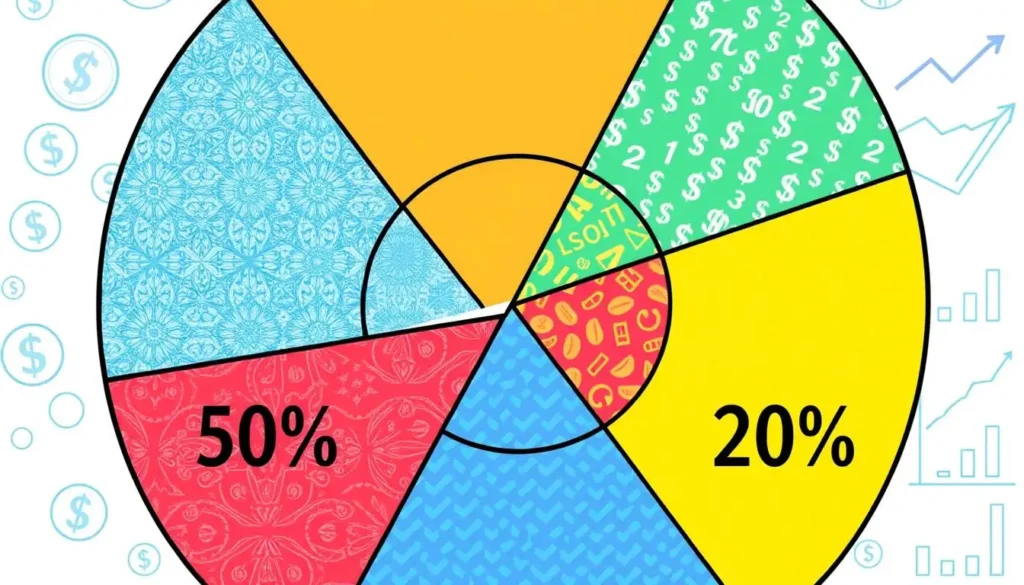Physical Address
304 North Cardinal St.
Dorchester Center, MA 02124
Physical Address
304 North Cardinal St.
Dorchester Center, MA 02124
Learn how to create a budget breakdown that works for your financial goals. Get practical tips to manage expenses, save money, and take control of your finances today

Are you struggling to make ends meet or feeling like your money is constantly slipping through your fingers? The key to financial freedom and stability may lie in mastering the art of budgeting. But where do you even begin? In this comprehensive guide, we’ll dive deep into the fundamentals of personal budgeting.
We’ll explore proven strategies to help you take control of your finances and achieve your financial goals.
To make a good budget, first figure out your take-home pay. This is your income after taxes and deductions for savings and insurance. With this number, you can start dividing your money for necessary expenses and discretionary spending.
About 50% of your after-tax income goes to necessary expenses. These are things like food, rent, utilities, and insurance. The other 30% is for discretionary spending, like eating out, gifts, and fun activities.
The last 20% should go to savings and paying off debt. This helps you reach your financial objectives. It could be saving for emergencies, retirement, or paying off high-interest loans.
By balancing your spending, you meet today’s needs and plan for tomorrow. Budgeting apps, spreadsheets, or the envelope method can help you track your spending. This keeps you on track with your financial goals.
“A budget is telling your money where to go instead of wondering where it went.” – Dave Ramsey
Keeping your finances in balance is key for a stable future. The 50/30/20 rule is a well-known method for budgeting. It suggests dividing your after-tax income into three parts: 50% for needs, 30% for wants, and 20% for savings and paying off debt.
This rule is flexible and easy to adjust. It helps make sure you cover your basic needs and still have money for fun and savings. It’s a simple way to keep your finances in check and work towards financial security.
If your spending categories take up more than 50%, you might need to tweak the percentages. Or, you could try a different budget like the 60/30/10 rule. The goal is to find a savings strategy that fits your life and money goals.
| Budget Category | Percentage of After-Tax Income |
|---|---|
| Needs (Essentials) | 50% |
| Wants (Discretionary) | 30% |
| Savings and Debt Repayment | 20% |
Following the 50/30/20 rule helps you balance your spending categories. It ensures you meet your basic needs, enjoy some treats, and save for the future. Remember, a good budget is personal and should fit your life and location. But the 50/30/20 rule is a great starting point for managing your money wisely.

Having a solid financial safety net is key for unexpected life events. Start by building an emergency fund for three to six months’ living expenses. This fund helps you avoid using retirement savings or getting into debt during tough times.
Automating savings for an emergency fund is easy and effective. Studies show people who struggle financially often lack savings. By setting aside a part of your paycheck each month, you can grow your emergency fund without spending it on non-essential things.
A starter emergency fund should be $1,000, but aim for 3–6 months of expenses. Your job stability, dependents, and health can guide how much you need.
Keep your emergency savings in a high-yield savings account or money market fund. This way, you have easy access and some returns. Don’t invest in riskier assets that could lose value when you need the money most.
Once your emergency fund is set, focus on retirement planning. If your employer matches 401(k) contributions, contribute enough to get the full match. It’s free money that boosts your retirement savings.
After maxing out employer matches, consider a Roth IRA for more retirement savings. These accounts offer tax-advantaged growth, which can greatly improve your financial security in the long run.
With your emergency and retirement savings in place, focus on paying off high-interest debt. This strategy frees up money and reduces interest payments over time. A well-planned debt reduction plan helps you achieve financial independence.
Building a strong financial base requires time and discipline. Focus on emergency savings, retirement planning, and managing debt responsibly. This will pave the way for your long-term financial goals.

Budgeting is a continuous process that needs regular checks and tweaks. It helps you reach your long-term financial goals and avoid overspending. It also makes saving for retirement simpler and prepares you for emergencies. By sticking to and improving your budget, you can achieve financial stability and meet your financial goals.
A budget is not set in stone; it should change as your life and finances do. Whether you’re handling personal money or a small business, a detailed budget is key for financial planning, budget management, and reaching your long-term goals for financial success.
Learning to budget well puts you on the path to controlling your financial future. It’s a step towards securing your financial freedom.
A budget is a plan for every dollar you have. It organizes your expenses, savings goals, and financial obligations. This helps you feel more in control of your money and makes saving easier.
First, figure out your after-tax income. Then, choose a budgeting system that works for you. Track your progress and automate your savings. Remember, your budget should change as your income and expenses do.
The 50/30/20 budget rule is a simple way to manage your money. It suggests using 50% for needs, 30% for wants, and 20% for savings and debt. This helps you stay on top of debt, enjoy life, and save for the future.
First, build an emergency fund with three to six months of living expenses. Include this in your budget. Next, save enough for your 401(k) to get the employer match. After that, focus on high-interest debt. Finally, aim to save 15% of your income for retirement.
Review and adjust your budget regularly. It helps you reach your long-term goals and avoid overspending. It also makes saving for retirement and emergencies easier. By keeping your budget up to date, you can achieve financial stability.